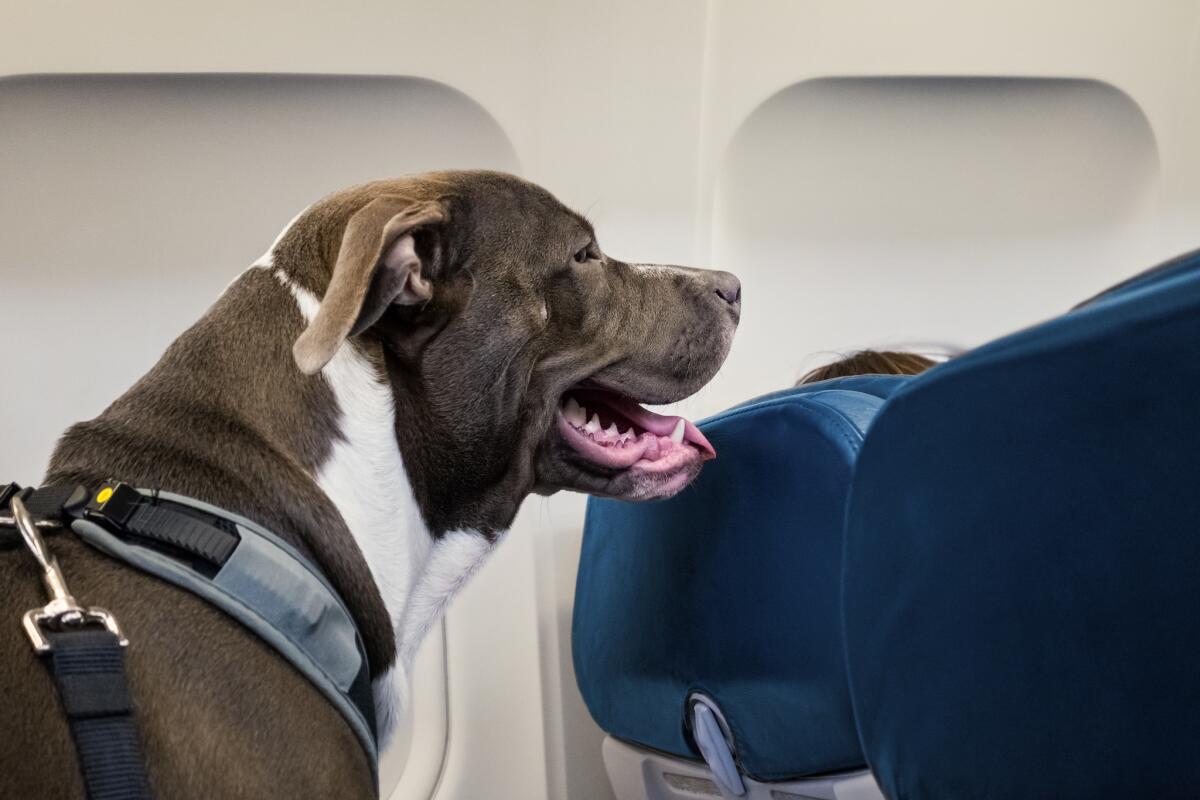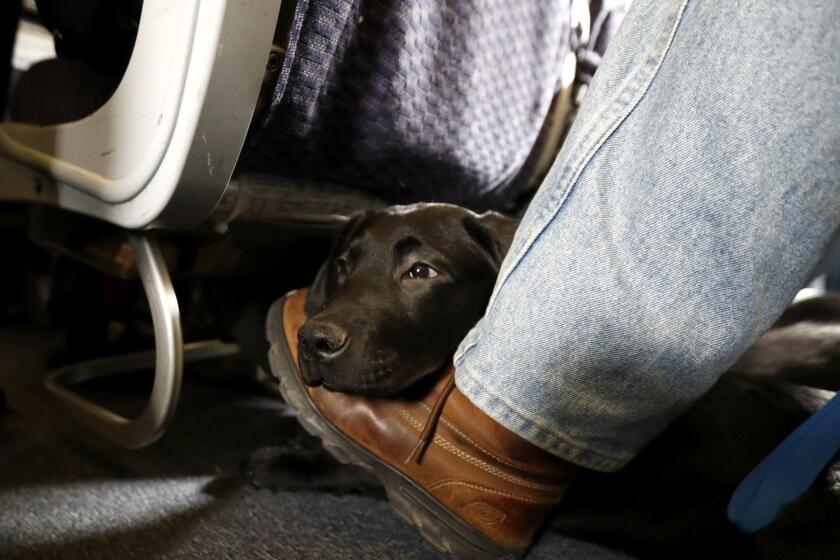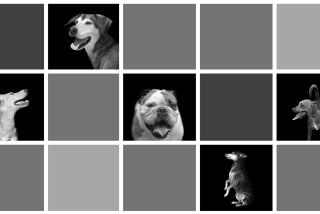Should emotional support animals be allowed on a plane? Make your voice heard

- Share via
Get ready for growls and howls. Watch out for whimpering and whining. Be prepared for snappishness and snarling. The U.S. Department of Transportation is proposing new rules for emotional support animals, and those regulations may be coming to an aircraft near you.
Some of you will applaud; some of you will be appalled. Of one thing I am fairly sure: Everyone will have an opinion by the time these rules become the law of the land and air.
At its core, here is what the DOT is proposing:
• Service dogs, properly trained, are animals that have jobs to do. They are not just pets. They are, however, dogs. No other creatures allowed.
• Pets that give emotional support but are not trained to do so will not be accorded the same rights and privileges as certified service dogs. This means your emotional support peacock or iguana does not get to sit in your lap or lie at your feet when you are airborne.
You have until April 6 to make your thoughts and feelings known to the DOT. (See box for how to comment, which is almost as complicated as filling out and filing your tax forms.)
What it means
Here is the DOT’s distilled version of the changes it proposes. It will:
“Define a service animal as a dog that is individually trained to do work or perform tasks for the benefit of a person with a disability.
“No longer consider an emotional support animal to be a service animal.”
Example of an allowable service animal: a guide dog for a person who is blind.
Example of an animal soon to be banished to an under-seat crate: a cute little pooch that’s essentially impersonating a service animal by wearing an “emotional support dog” vest to bolster its claim that it’s necessary for well-being and it shouldn’t have to pay.
DOT makes it clear in its manifest that it has wised up to this game: “Passengers wishing to travel with their pets may be falsely claiming that their pets are service animals so they can take their pet in the aircraft cabin or avoid paying pet fees charged by most airlines since airlines cannot charge service animal users a fee to transport service animals.”
By trying to be inclusive, airlines (and the DOT) let the matter get out of hand by failing to define what constitutes a service animal. It explains how:
“DOT’s current [Air Carrier Access Act] regulations also require airlines to recognize emotional support animals as service animals. Consequently, a restaurant in an airport could, without violating [Department of Justice] rules, deny entry to an emotional support animal that an airline, under the ACAA, would have to accept.”
That leniency has led to an increasing number of complaints about service animals (which, under the air carrier act, includes emotional support animals) filed with the airlines, DOT notes: from 719 in 2013 to 3,065 five years later.
The question now is whether the DOT is proposing to do a disservice to people who do need those animals and aren’t trying to game the system.
No dogfight broke out after the March 25 “On The Spot” column (“Fur Will Fly in This Debate”), which raised the fraught issue of emotional support animals flying in airline cabins.
Sandra Barker, professor emeritus of psychiatry at Virginia Commonwealth University in Richmond, would like to see “evidence-based studies” that show how untrained ESAs contribute to the mental health of patients.
It’s not that she does not believe in the value of the animal/human bond. She is one of the authors of “Animal-Assisted Interventions in Health Care Settings: A Best Practices Manual for Establishing New Programs” as part of her work with the Center for Human-Animal Interaction at VCU. The Dogs on Call program at VCU uses trained dogs to address stress among patients and staff.
Is there place for ESAs on airplanes? Not as we now know them. But, said Catherine Salmon, a professor of psychology at the University of Redlands and a member of the Human-Animals Studies program at the university, the tide could turn with training of those animals. She called the fear of what an untrained animal might do a “valid concern.”
“I think if a system could be set up — if ESAs can have the same kind of training and can be part of the same system that is regulated in some of the same way — that could work,” she said.
But would that change the human-animal equation? Perhaps. Pet owners — and I am among them — are in service to our pets. A service animal is in service to its owner, which makes the relationship more complex, Salmon said. The bond extends far beyond “Who’s a good boy?”
All of this before we’ve gotten to the topic of allergies and whether it’s fair to expose passengers to that — even if it is a trained service animal. Yet another reason passengers are getting their dander up.
To express an opinion
If you’d like to tell us what you think, please write to [email protected]. Or you can use the “Comments” section below this article.
If you would like to share your thoughts with the DOT, go to Regulations.gov. Type in the docket number (DOT–OST–2018–0068) and the Regulatory ID number (RIN No. 2105–AE63). You also may send a letter to Docket Management Facility, U.S. Department of Transportation, 1200 New Jersey Ave. S.E., West Building Ground Floor, Room W12–140, Washington, D.C. 20590–0001 or by fax at (202) 493–2251. Make sure any communication has the docket and Regulatory ID numbers above.
More to Read
Sign up for The Wild
We’ll help you find the best places to hike, bike and run, as well as the perfect silent spots for meditation and yoga.
You may occasionally receive promotional content from the Los Angeles Times.








